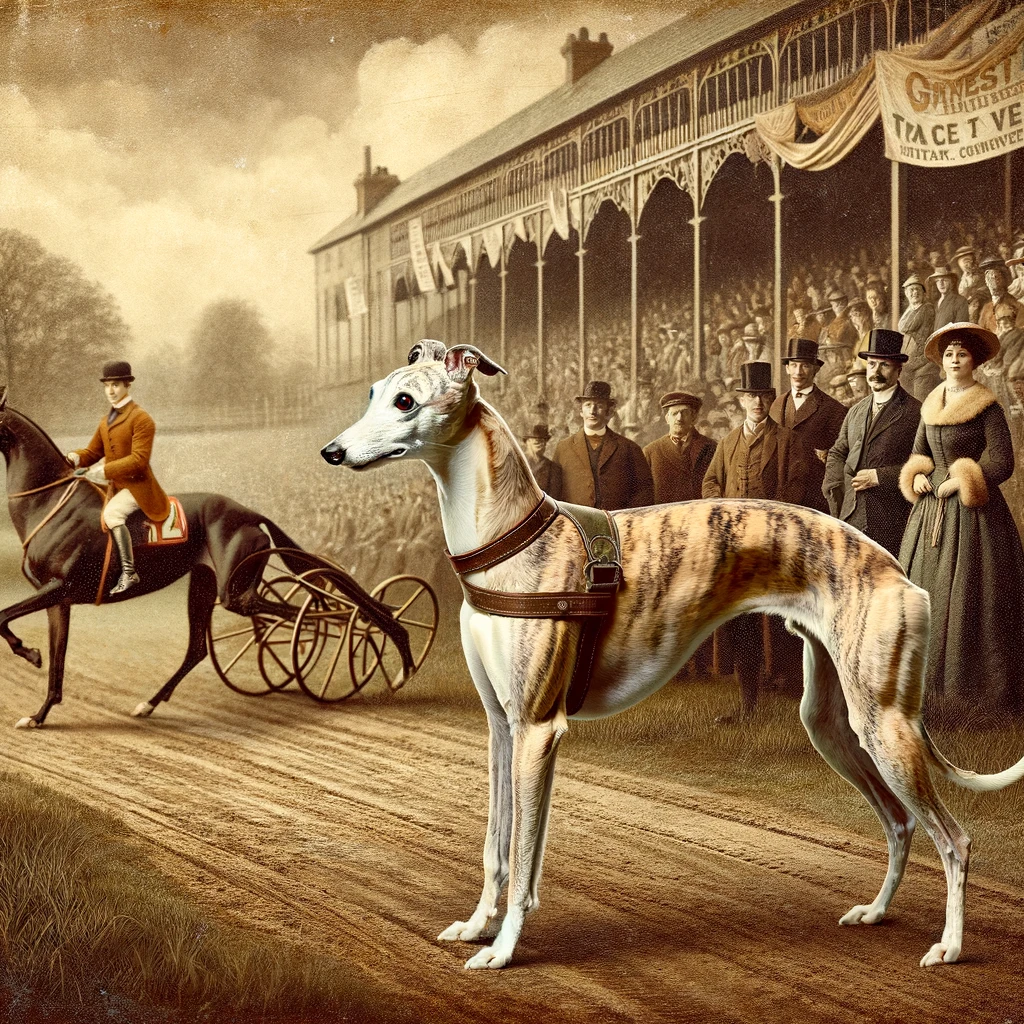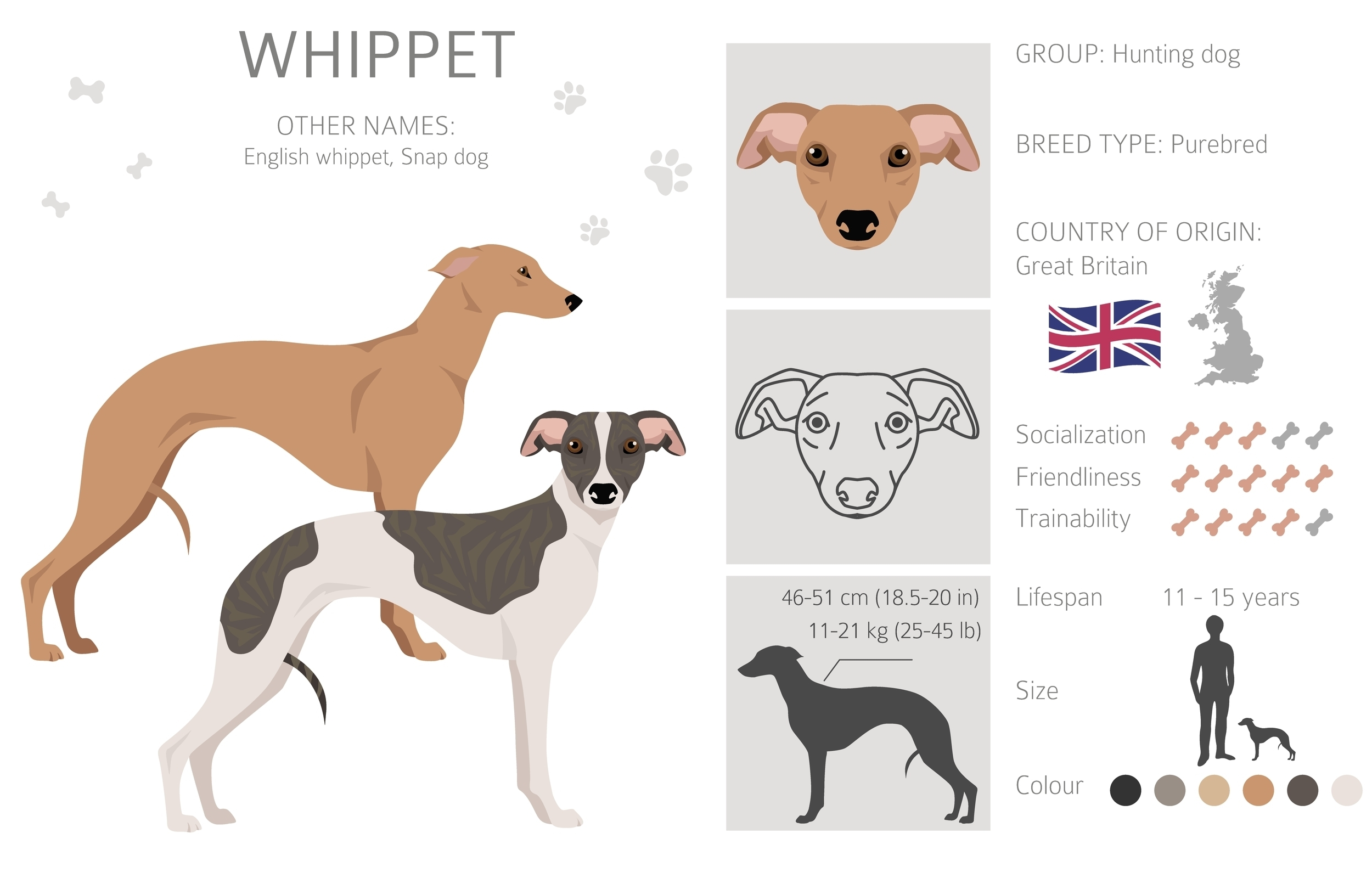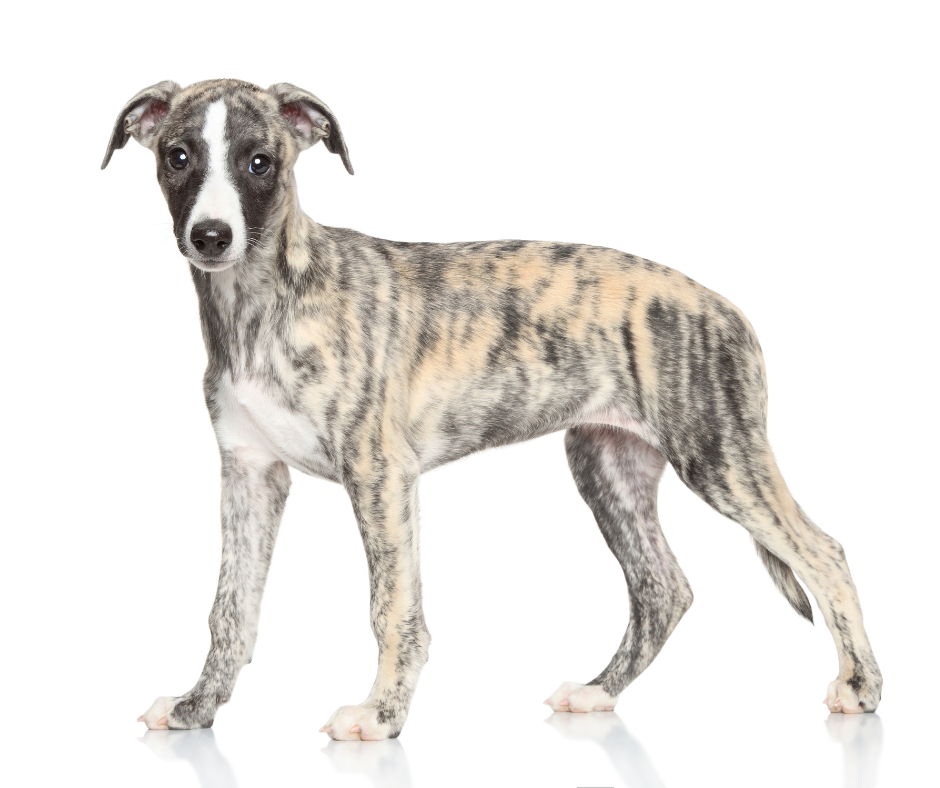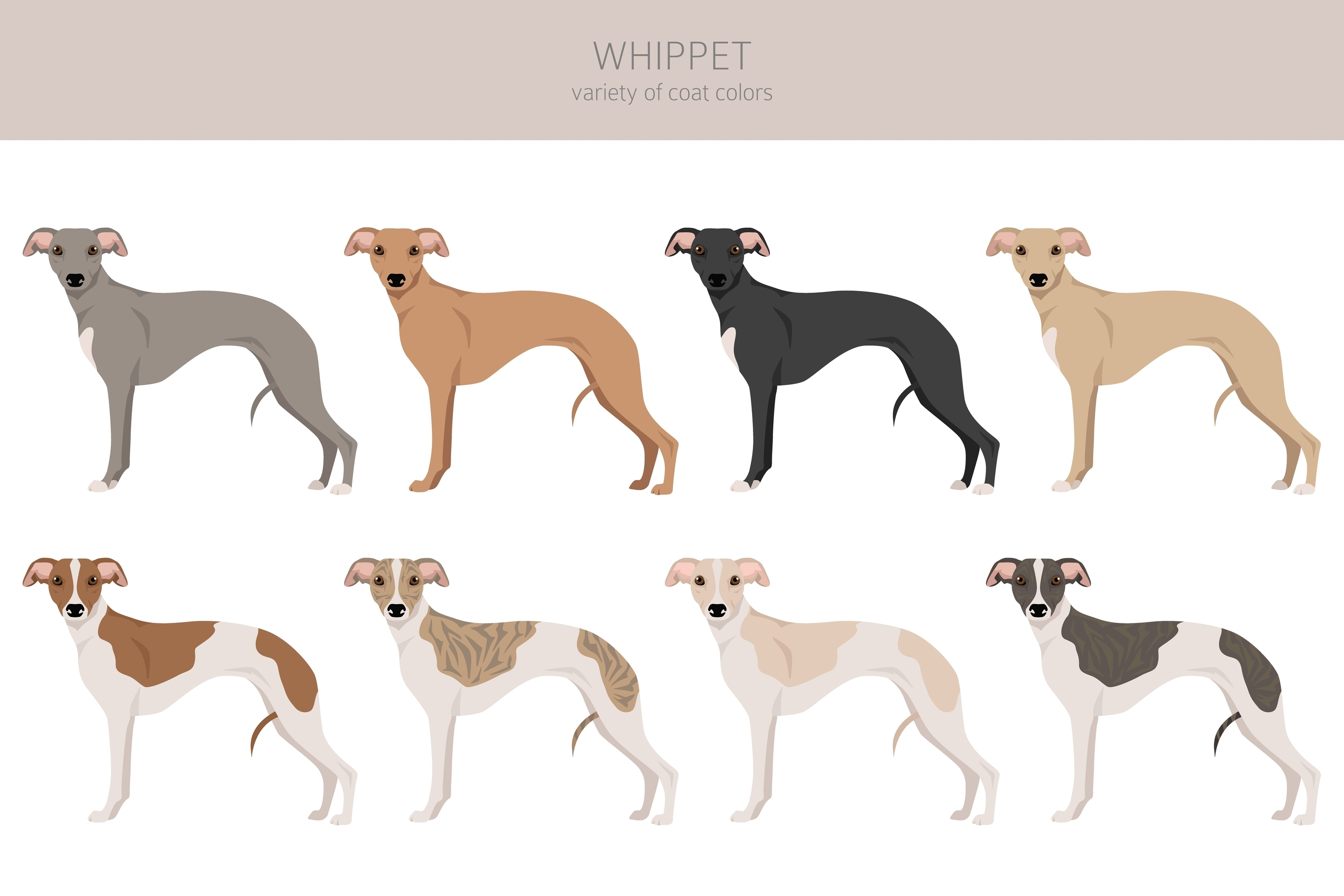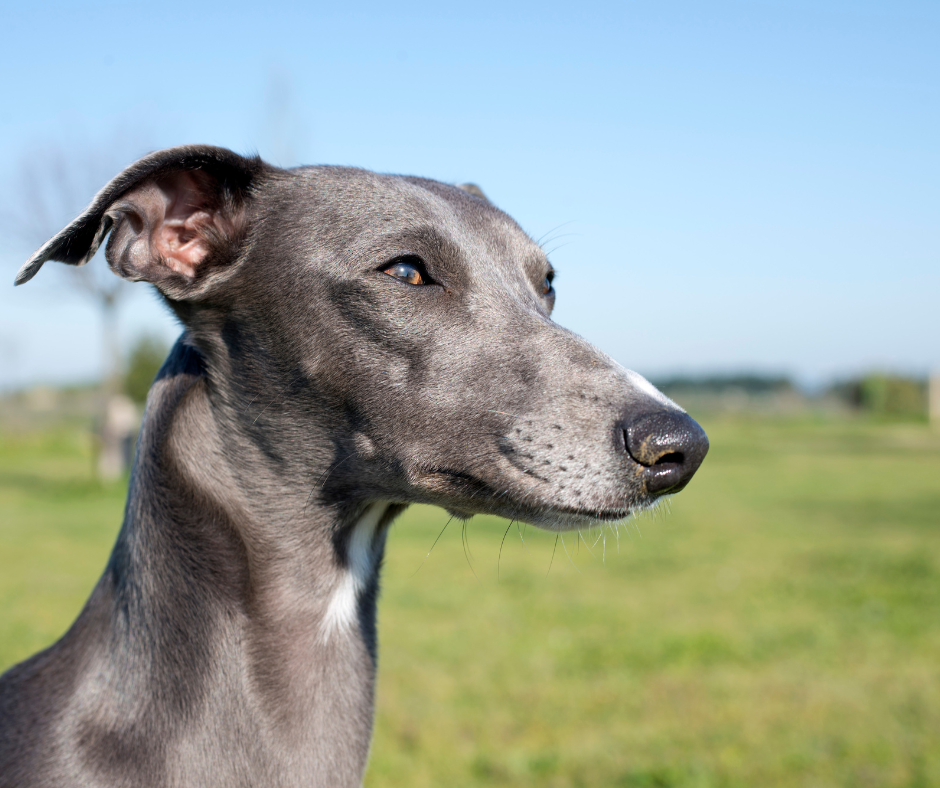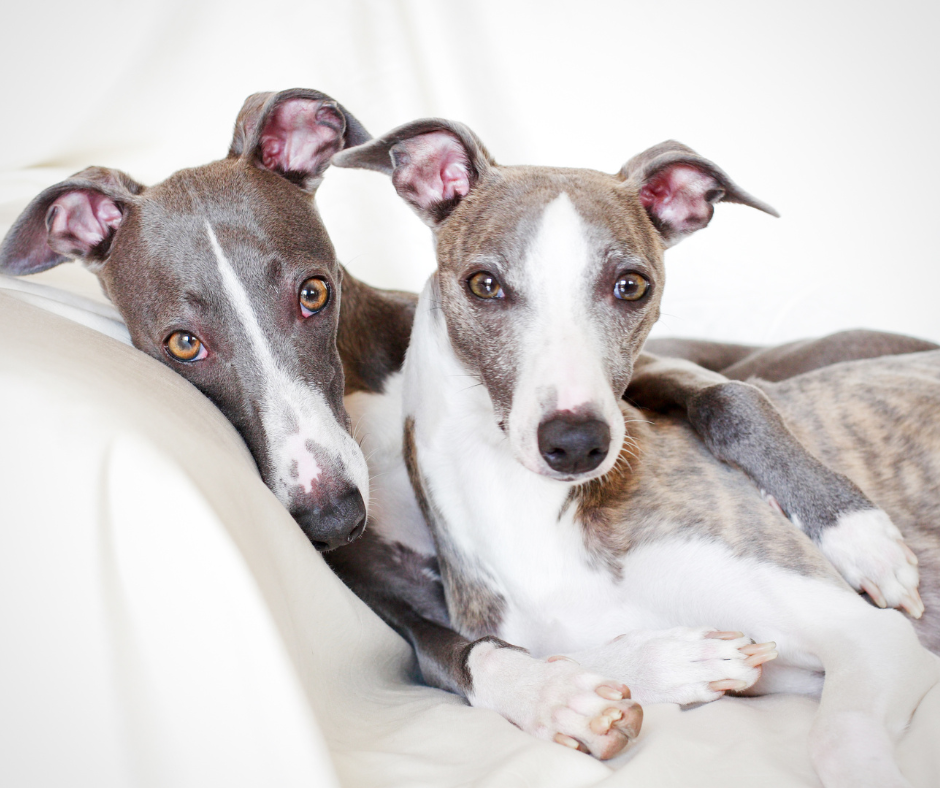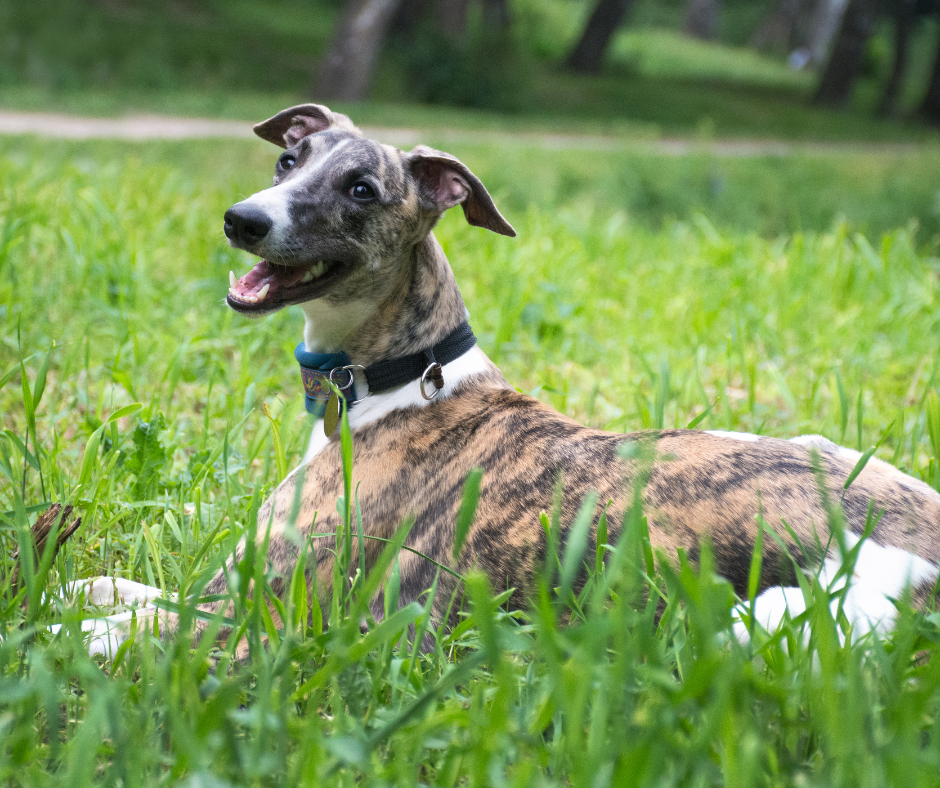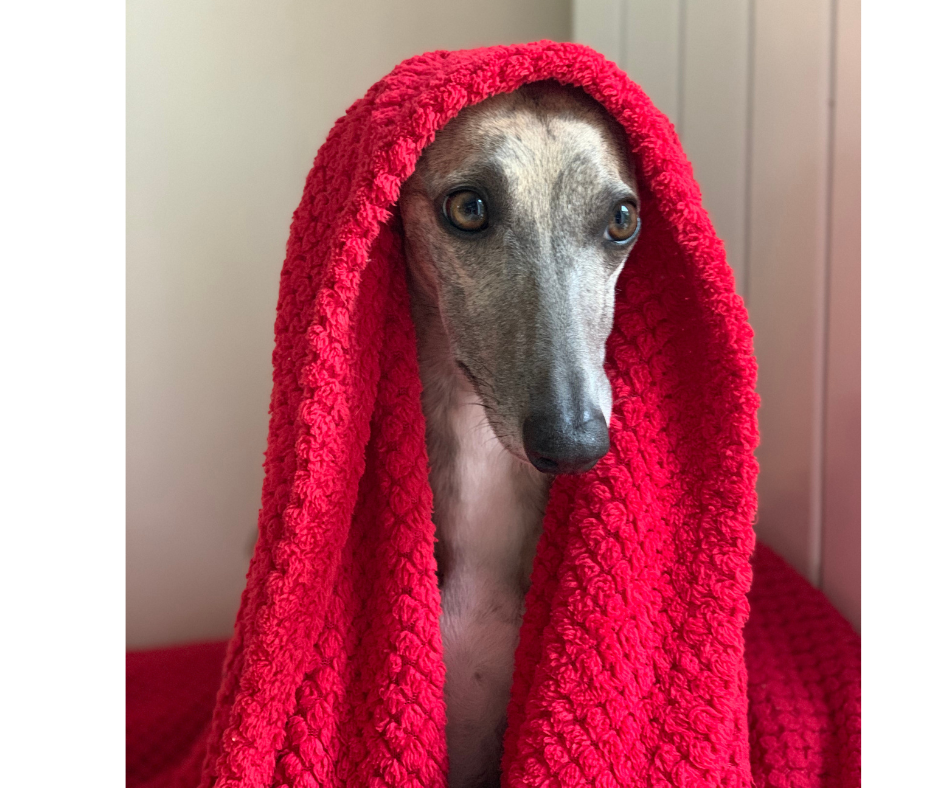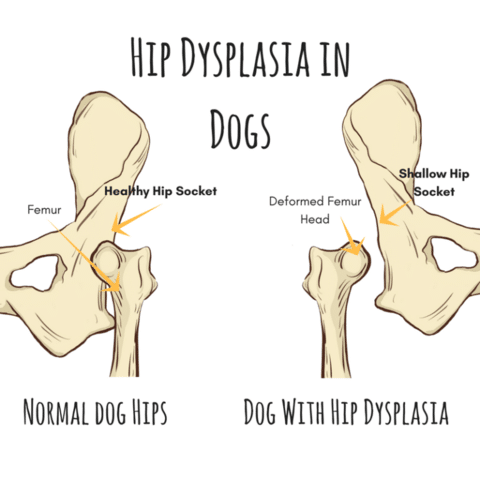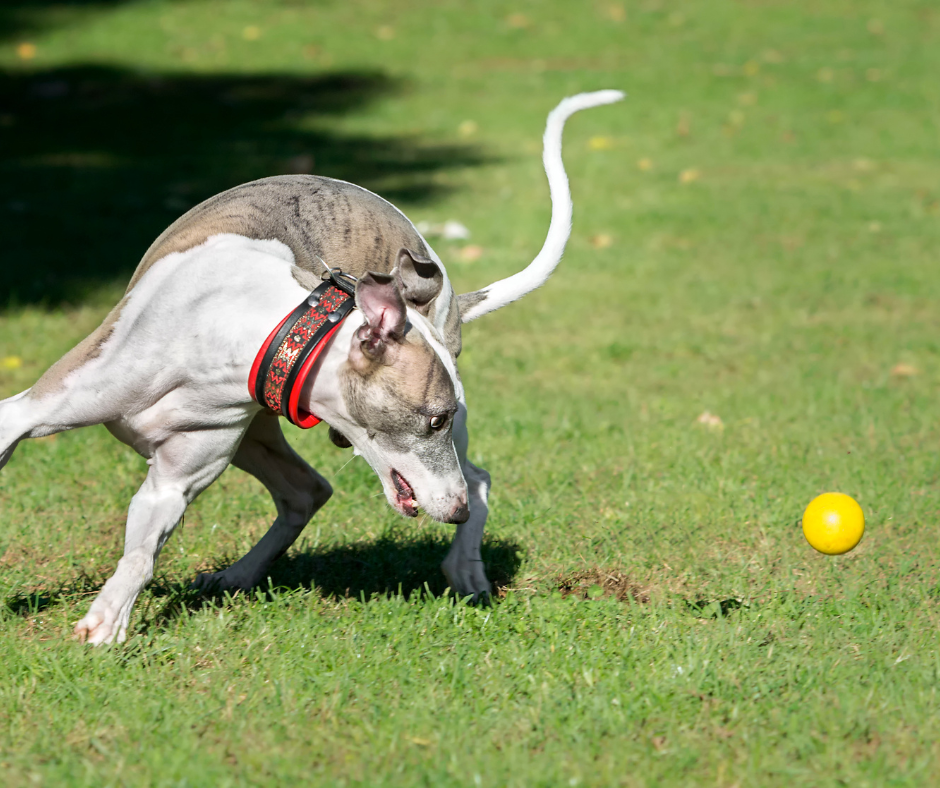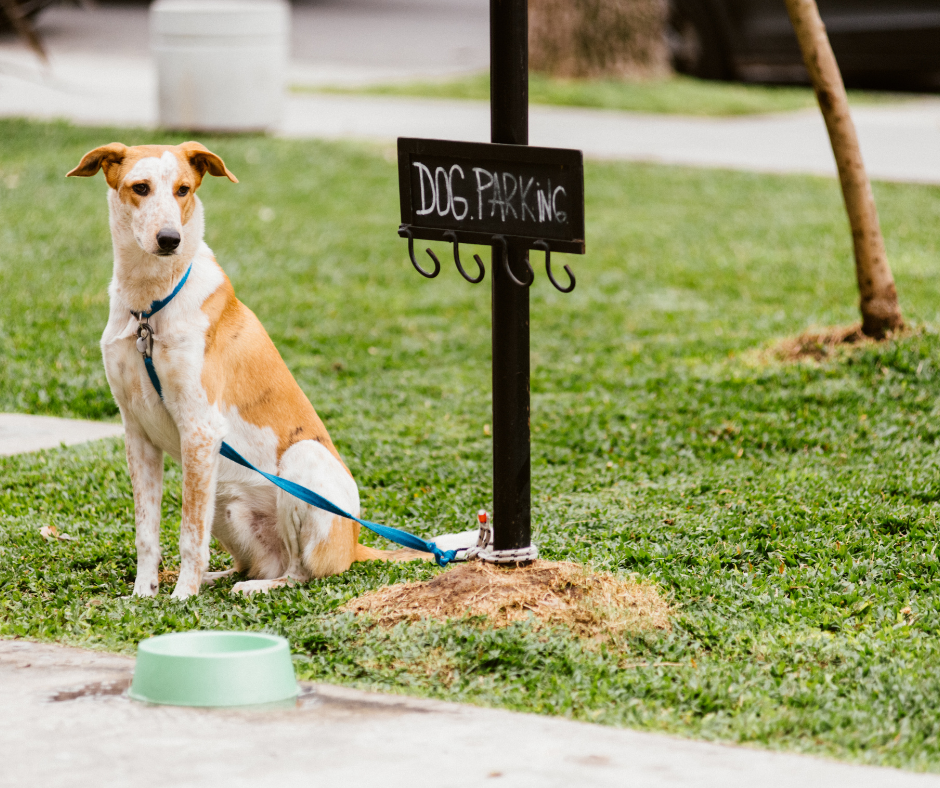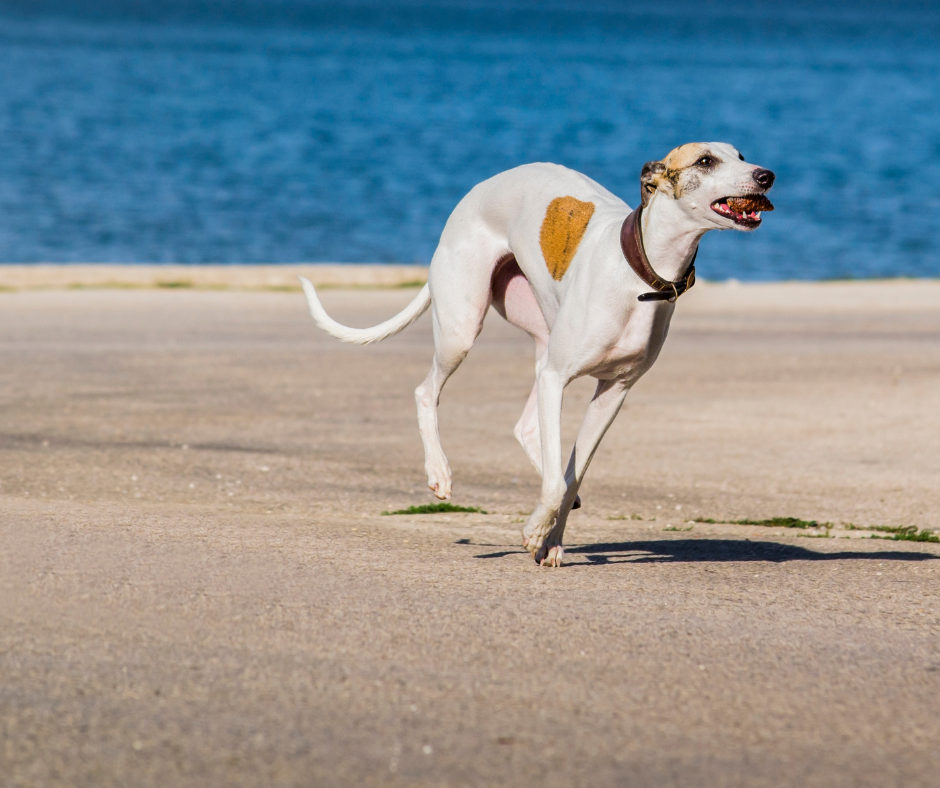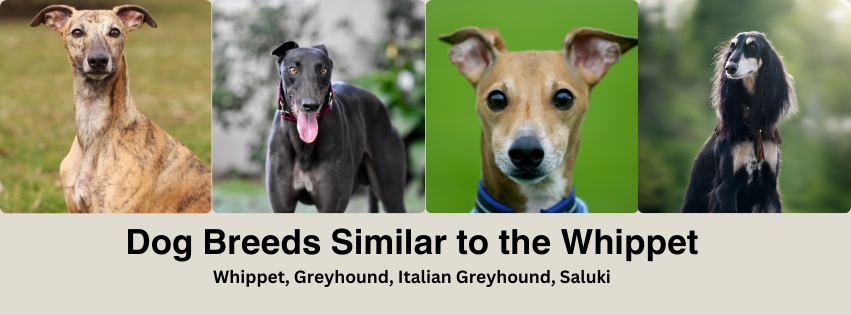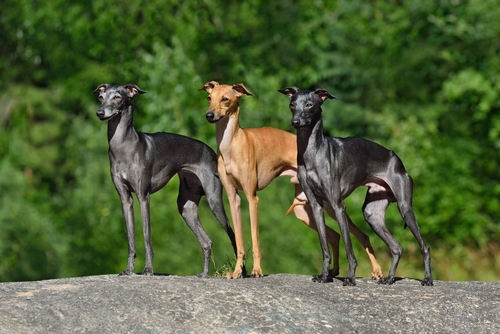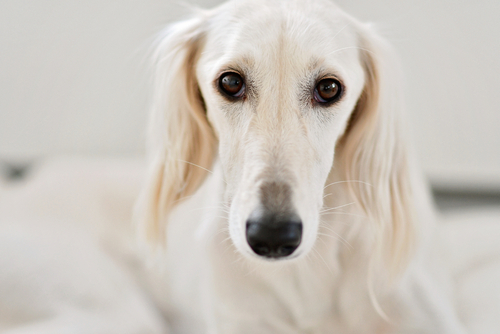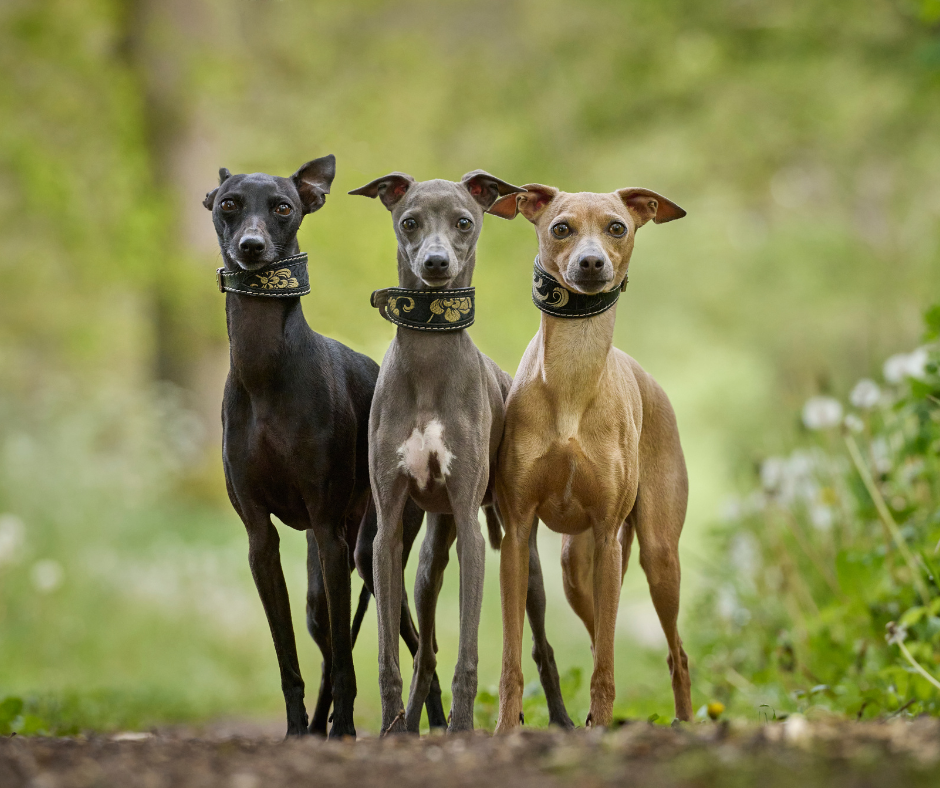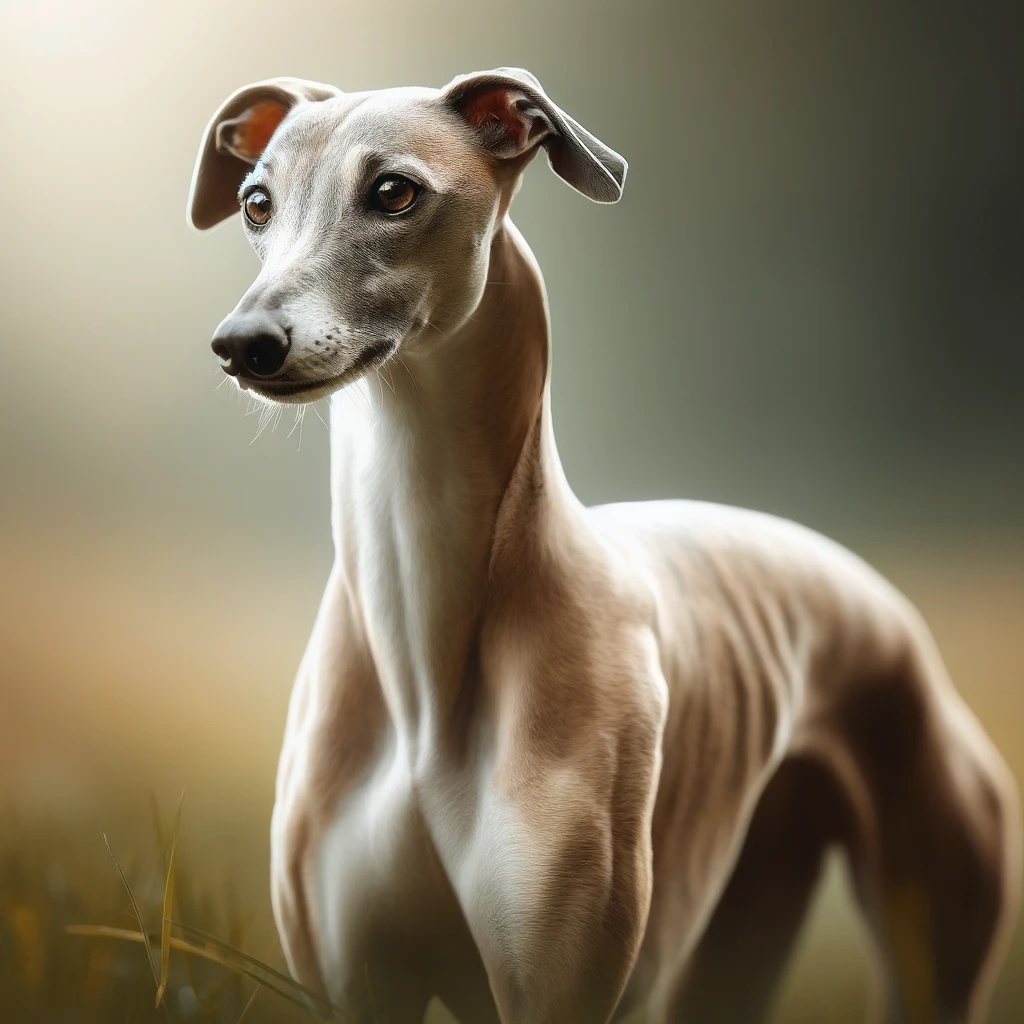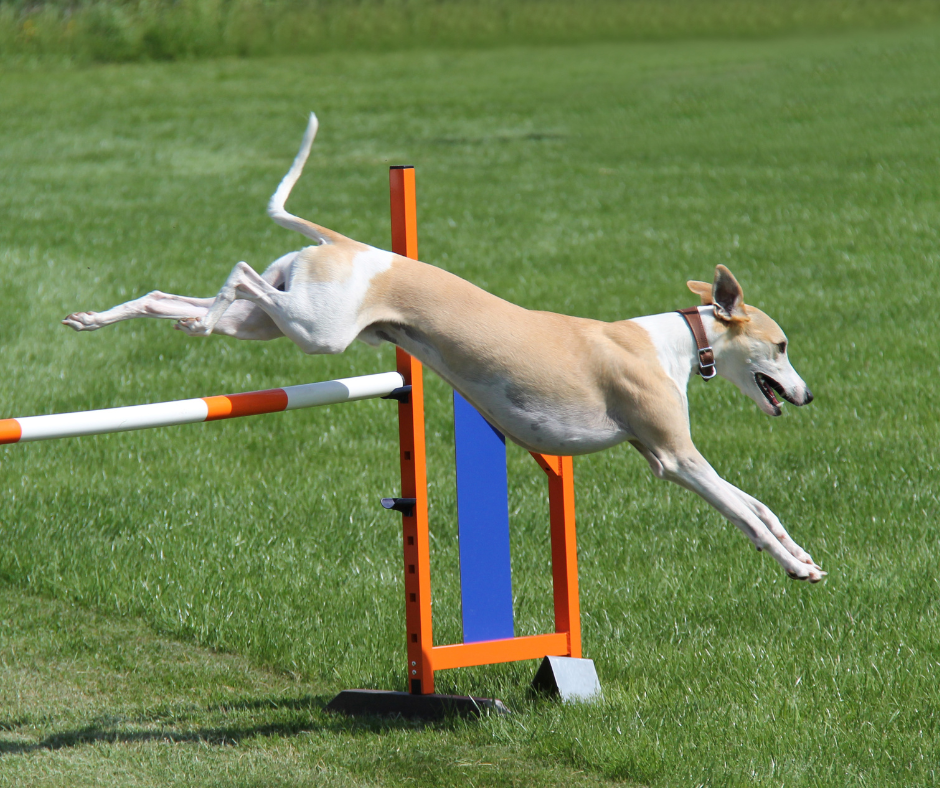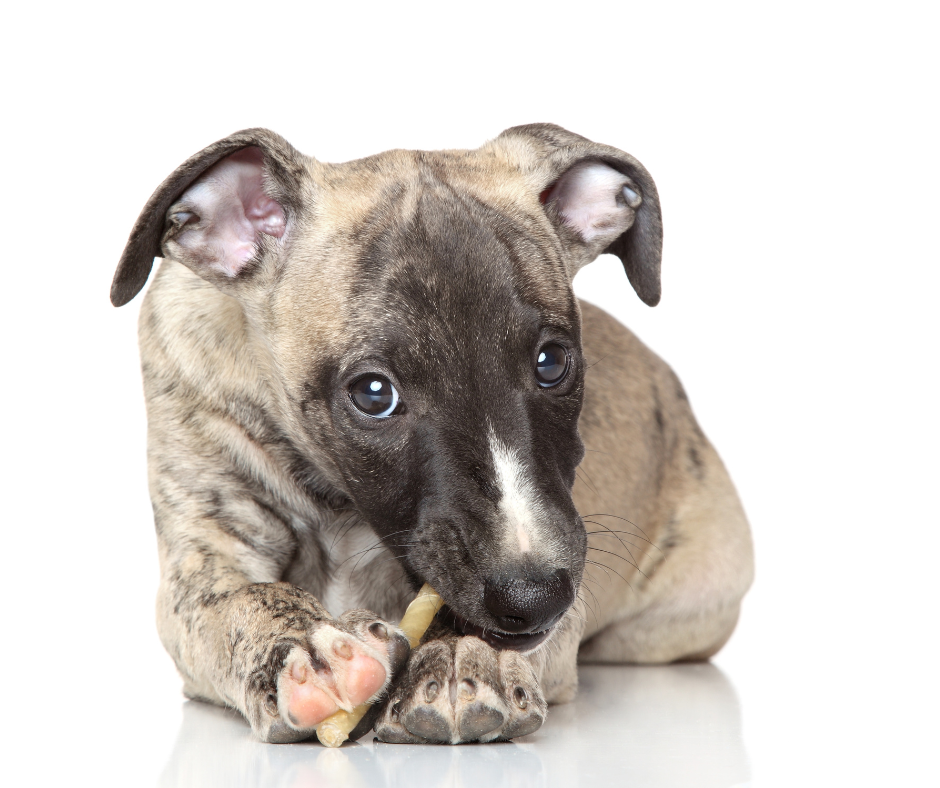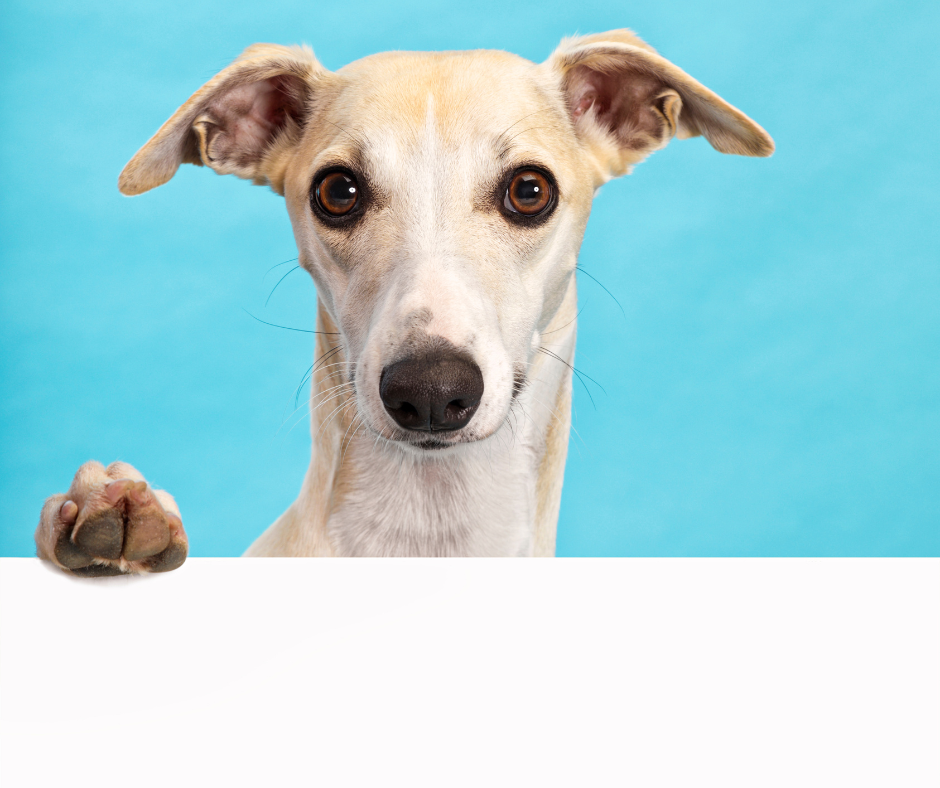Whippet

At the end of the 18th century, small Greyhounds were crossed with various terriers to create a breed capable of dispatching vermin and coursing rabbits. Known as “the poor man’s racehorse,” the Whippet gained popularity among miners for organized rat-killing competitions. Today, while retaining their hunting prowess, Whippets are more commonly gentle and affectionate companions, content to snuggle on the couch.
The Whippet combines regal grace with athleticism. Their sharp vision makes them effective at keeping homes free of small pests, although their tendency to snatch food off countertops can be a humorous challenge. They feature a short coat that is easy to maintain, adding to their appeal.
Friendly and generally quiet, Whippets are not suited to guard dog duties but alert you to visitors and noises. They thrive in a family setting, get along well with children and other pets, and are easy to train, although they dislike walking in bad weather.
Despite their agility, Whippets must be leashed during walks to prevent them from chasing moving objects. They enjoy freedom in secure areas, where they display their joy in running. However, their strong prey drive can be problematic for homes with smaller pets unless carefully managed from a young age.
Whippets can develop boredom and destructive behaviors if left alone or unstimulated. Regular walks and trips to the dog park are essential. They love soft furniture and, despite their intelligence, can be stubborn about training. They excel in canine sports like lure coursing and agility rather than obedience trials.
Maintaining a Whippet’s coat is straightforward, requiring regular brushing, nail trims, teeth cleaning, and ear care to keep them in top condition.
Sleek Sprinters: Exploring the Athletic Elegance of the Whippet Dog Breed
The Whippet, also called the snap dog, is a breed that epitomizes elegance and speed, stands as a distinguished figure in the canine world. Known for its slender, streamlined body and graceful demeanor, the Whippet is often described as the ideal amalgamation of athletic prowess and gentle companionship. Originally bred for racing and rabbit hunting, their history is deeply rooted in the working-class culture of Victorian England, where they earned the moniker “the poor man’s Greyhound”
Characterized by a distinct appearance and swift movements, Whippets possess a remarkable ability to accelerate to top speeds, making them formidable competitors in lure coursing and dog racing events. Despite their athletic nature, they are equally known for their mild and affectionate temperament. This blend of traits makes the Whippet a versatile companion, capable of thriving in diverse living environments from bustling city apartments to spacious rural homes.
Moreover, the breed’s sleek coat, which comes in a variety of colors and patterns, and their expressive eyes add to their aesthetic appeal, allowing them to stand out not only in performance but also in conformation shows. This combination of form and function encapsulates the unique stature of Whippets in the canine hierarchy, cherished both as athletic sports dogs and affectionate pet companions.
History and Origin of the Whippet
The Whippet, a sighthound breed known for its speed and agility, has a rich history that traces back to the industrial era of England. Originally bred from Greyhounds, the Whippet was designed to be a smaller, more versatile version suitable for rabbit hunting and racing, activities that were both affordable and popular among the working class. Whippets were among the ‘dogs bred’ for specific purposes like racing and hunting due to their speed and agility.
Development of the Breed
The origins of the Whippet date back to the late 18th century when miners in Northern England began racing dogs as a form of entertainment and a way to potentially earn extra money. These dogs were initially a diverse group, bred from various terriers and Greyhounds, which led to the creation of a distinct type that was adept at hunting small game over short distances.
By the 19th century, with the advent of formal dog shows and the rising popularity of pedigree dog breeding, the Whippet began to gain recognition as a breed in its own right. It was during this time that the breed’s characteristics were refined to enhance its elegance and speed. The first official standard for the Whippet was established in England in 1891.
American Kennel Club Recognition of the Whippet Breed
The Whippet was introduced to America in the late 19th century and quickly gained popularity as a racing and hunting dog. Its graceful appearance and friendly nature made it a favorite in dog shows and homes alike. The American Kennel Club (AKC) recognized the Whippet as a breed in 1888, solidifying its status in the United States. This recognition came at a time when dog racing and coursing were becoming popular pastimes in America, and the Whippet’s skills were highly valued.
Evolution of the Breed’s Role
While originally bred for practical hunting and racing uses, the Whippet’s role has evolved significantly over the years. Today, they are cherished primarily as companion animals, known for their gentle and affectionate demeanor. However, their heritage still plays a role in modern activities such as lure coursing, a sport that simulates the chase of game with a mechanically operated lure—perfect for a breed with such a strong prey drive.
Physical Characteristics of the Whippet
Among the vast array of dog breeds, the Whippet stands out due to its unique physical characteristics, sleek coat, and athletic build. This breed is renowned for its speed, agility, and graceful appearance, making it a distinctive member of the canine community.
Size and Build
Whippets are distinguished by their slim, streamlined build, ideal for high-speed pursuits. Male Whippets typically stand between 18 to 22 inches at the shoulder, while females are slightly smaller, ranging from 17 to 21 inches. Males weigh about 25 to 40 pounds, with females ranging from 20 to 35 pounds. Their lightweight structure significantly enhances their agility and rapid movement capabilities.
Coat Texture and Maintenance
The Whippet’s coat is short, smooth, and firm, requiring minimal grooming. This low-maintenance coat provides an aerodynamic advantage crucial for speed. It also has a subtle sheen that enhances the breed’s elegant appearance, making Whippets attractive both in the show ring and as stylish companions.
Color Variations
Whippet coats vary widely in color, featuring shades like black, white, red, blue, cream, and fawn, often combined with spots or patches. Patterns such as brindle and ticked coats are common, giving each Whippet a unique look that appeals to potential owners.
Conformation and Proportions
Whippets exhibit a balanced, refined conformation. They have a long, lean head that tapers to the muzzle, complemented by expressive eyes and rose-shaped ears that add to their alert and intelligent expression. The ears fold back when at rest and may perk up when the dog is alert. A well-defined neck flows into laid-back shoulders, leading to a deep chest that aligns with the elbows. The breed’s prominent sternum provides ample space for lung expansion during sprints. The strong, moderately long back and low-set tail with a slight upward curve contribute to their flexibility and speed.
Gait and Mobility
A Whippet’s gait is smooth and powerfully efficient, characterized by a double-suspension gallop that allows for swift coverage of ground. This locomotive efficiency is a hallmark of sighthounds and underscores the Whippet’s capability in activities requiring sudden bursts of speed.
Temperament and Personality
Whippet Temperament and Social Interactions
Whippets are known for their docile and affectionate temperament, making them excellent companions both in active households and quiet homes. They exhibit a striking dual personality – energetic and playful when outdoors, yet calm and reserved when inside. This adaptability makes them well-suited to a variety of living conditions, from apartments to houses with sprawling yards.
Interaction with Humans
With humans, Whippets are generally gentle and friendly. They form strong bonds with their family members and are known for their loyalty and affection. They are particularly sensitive to moods and emotions, often seeking to comfort their owners with their presence. Whippets are usually not overly demanding of attention, but they cherish human companionship and do not like to be left alone for long periods. This can lead to separation anxiety, manifesting as destructive behavior or excessive barking if they are not adequately trained or accustomed to being alone.
Whippets are also good with children, displaying patience and a protective instinct. However, because of their gentle nature, they are best suited to families with well-behaved children who know how to interact respectfully with animals. Their friendly disposition extends to strangers as well, though they can be initially reserved. With proper introduction and socialization, they warm up quickly, showcasing their inherent curiosity and warmth.
Interaction with Other Animals
Regarding other animals, Whippets can exhibit a range of behaviors based on their upbringing and individual temperament. By nature, they are sighthounds, bred for chasing fast-moving prey. This instinct can sometimes lead them to chase smaller animals like cats, squirrels, or rabbits. However, many Whippets live peacefully with other pets, including cats, especially if they have been raised together from a young age. Socialization plays a critical role in this aspect of their behavior. Exposing them early and often to various animals can enhance their ability to coexist with other pets peacefully.
When interacting with other dogs, Whippets are typically friendly and playful. They enjoy the company of their canine counterparts and can often be seen engaging in spirited chases and games. However, their play style might be too vigorous for some smaller or more reserved dog breeds. In dog parks or social settings, they tend to perform well, though their chase instinct might require close supervision in unfenced areas to prevent them from sprinting after perceived prey.
Behavior in Various Social and Solitary Scenarios
In social scenarios, such as family gatherings or public outings, Whippets generally behave well. They manage to stay calm and composed, though they do appreciate a quiet retreat to decompress if the environment becomes too overwhelming. Their sensitivity to stress and loud noises means that owners should be mindful of their environment and the potential for overstimulation.
In solitary scenarios, when left to their own devices, Whippets often indulge in their favorite pastime: lounging. Known for their love of comfort, they can usually be found curled up on a couch or bed, enjoying a nap. However, without adequate exercise and mental stimulation, they can develop undesirable behaviors. Regular play sessions, walks, and interactive toys are essential to keep them engaged and prevent boredom.
Adaptability
The adaptability of Whippets is one of their most endearing traits. They are as comfortable being the center of attention in a lively house as they are being a quiet companion in a more sedate setting. They adjust their energy levels accordingly, proving themselves to be versatile companions capable of fitting into a variety of lifestyles.
The behavioral traits of Whippets, characterized by their calm demeanor interspersed with bouts of high energy, make them fascinating and beloved companions. Their ability to seamlessly integrate into family life and their interactions with humans and other animals highlight their amiable and adaptable nature, suited to a range of social environments.
Whippet Health and Care
Additionally, for purebred dogs such as Whippets, it’s crucial to ensure they undergo health screenings to confirm they are healthy and to maintain the integrity of the breed.
Read More: Understanding Purebred Dogs
Common Health Issues in Whippets
Whippets are generally healthy dogs, but like all breeds, they are prone to certain health conditions. Being aware of these common issues can help owners seek preventative care measures and ensure timely treatment.
Cardiovascular Concerns
Mitral Valve Disease (MVD): This is a common heart condition in Whippets, particularly as they age. It involves the deterioration of the mitral valve, which can lead to heart failure if untreated. Regular veterinary check-ups can detect early signs of MVD.
Arrhythmias: Whippets may also experience irregular heartbeats, which can sometimes lead to more serious cardiac issues. Monitoring their heart rate and rhythm through routine vet visits is advisable.
Musculoskeletal Problems
Hip Dysplasia: Although less common than in larger breeds, hip dysplasia can affect Whippets. This malformation of the hip joint can cause pain and arthritis. Keeping your Whippet at a healthy weight and providing regular, appropriate exercise can help manage this condition.
Luxating Patellas: This condition involves the dislocation of the kneecap, which can be occasionally seen in the breed. While genetic in nature, maintaining a healthy weight and muscle tone can reduce the stress on the knees.
Eye Issues
Progressive Retinal Atrophy (PRA): This degenerative eye disorder eventually leads to blindness from the loss of photoreceptors at the back of the eye. Regular eye exams are essential to spot any early signs of this condition.
Corneal Dystrophy: Whippets may develop this condition, where abnormal material accumulates in the cornea. Although it is usually not painful, it can sometimes impair vision, necessitating veterinary attention.
Dermatological Conditions
Skin Allergies: Whippets can be prone to skin allergies, which may manifest as itchiness and dermatitis. Allergens can include food ingredients, pollen, or fleas. Identifying and removing the allergen source is crucial, along with appropriate medical treatment to ease symptoms.
Other Health Concerns
Anesthesia Sensitivity: Whippets have less body fat than many breeds, making them more sensitive to certain anesthetics. Discussing safer anesthesia options with your veterinarian is crucial before any surgical procedure.
Preventative Health Measures
Regular veterinary check-ups are crucial for maintaining the health of your Whippet. These check-ups should include cardiac, eye, and joint exams, especially as your Whippet ages. Vaccinations, parasite control, and dental care are fundamental aspects of preventative measures that contribute to a longer, healthier life.
Dietary Needs
Whippets need a balanced diet rich in nutrients. High-quality commercial dog food or well-planned home-cooked meals (under veterinary guidance) can meet their nutritional requirements. It’s essential to monitor their caloric intake as Whippets can gain weight easily, especially with their fondness for lounging. Foods rich in omega fatty acids can help maintain their coat’s health, and antioxidants may prevent aging-related health issues.
Read More: How to Choose the Best Dry Dog Food
Exercise Routines
Whippets require regular exercise to maintain their muscle tone and prevent obesity. Despite their bursts of high-speed running, they do not need excessive exercise. Daily walks combined with opportunities to run in a secure area are usually sufficient. Mental stimulation is also crucial, so engaging in training activities, puzzle games, and social interactions contributes to their overall well-being.
The health and care of Whippets, therefore, involve a combination of regular medical check-ups, a balanced diet, and consistent exercise. Addressing the breed-specific health issues early on through preventative measures can lead to a fulfilling and healthy life for these graceful companions.
This part will delve into the training methodologies suitable for Whippets and activities that harness their natural abilities.
Training and Activities Suitable for Whippets
In addition to lure coursing, Whippet racing is another activity that showcases their natural speed and agility, appealing to their racing and chasing instincts.
Read More: Dog Training 101
Training and Activities Suitable for Whippets
Training a Whippet requires an understanding of their temperament and physical capabilities. Known for their intelligence, speed, and agility, Whippets respond well to training that incorporates positive reinforcement and activities that fulfill their natural inclinations.
Training Tips for Whippets
1. Positive Reinforcement: Whippets are sensitive dogs that do not respond well to harsh corrections. Using treats, praise, and toys as rewards for good behavior is more effective. This breed is motivated by incentives, and positive reinforcement also helps strengthen the bond between the dog and its owner.
2. Consistency is Key: Like most dogs, Whippets benefit from consistent training sessions. Short, frequent training periods are preferable to sporadic, lengthy sessions, which can lead to a Whippet losing interest. Typically, sessions should last between 5 to 10 minutes to maximize attention and effectiveness.
3. Socialization: Early socialization is crucial for Whippets, exposing them to various people, sounds, environments, and other animals. Well-socialized Whippets are more likely to develop into well-rounded adults, managing their speed and chase instincts better in diverse settings.
4. Obedience Training: Basic obedience commands such as sit, stay, come, and down are essential. Training a Whippet in recall is particularly crucial given their strong prey drive. A reliable recall ensures they can enjoy running off-leash without posing a risk to themselves or to wildlife.
5. Leash Training: Given their high prey drive, leash training is vital. Whippets need to learn to walk on a leash without pulling, making walks enjoyable for both pet and owner. Introducing a harness can be beneficial, distributing the force if they lunge or dart after something.
Suitable Activities for Whippets
1. Lure Coursing: This sport is a natural fit for Whippets, who were originally bred to chase fast-moving prey. Lure coursing simulates this with a mechanically operated lure on a course, providing mental and physical exercise. It allows them to use their speed and maneuverability in a controlled environment.
2. Sprinting and Racing: Short-distance racing or sprinting harnesses a Whippet’s natural inclination to run fast. Organized sprinting events can provide a safe and competitive outlet for their energy.
3. Agility Training: Agility courses are excellent for Whippets, giving them an outlet to showcase their nimbleness and speed. Training for agility sharpens their minds and satisfies their need for physical activity, while also strengthening their obedience skills.
4. Flyball: Another sport well-suited to the Whippet’s capabilities is flyball, which involves teams of dogs racing against each other from a start/finish line, over a line of hurdles, to a box that releases a tennis ball when pressed. It combines the Whippet’s problem-solving abilities with their speed.
5. Canine Freestyle: Known as “dance for dogs,” this activity allows Whippets to engage in a mixture of obedience, tricks, and dance moves choreographed to music. It’s a creative way to engage their minds and bodies, and can be a delightful bonding activity.
6. Tracking: Utilizing their strong sense of smell, tracking can be a rewarding activity for Whippets. It involves the dog recognizing and following a scent trail, which can be both a competitive sport and a fun, mentally stimulating activity.
By catering to their unique traits such as their swiftness, agility, and keen intelligence, training and activities for Whippets can be both rewarding and enjoyable. Harnessing their natural abilities not only keeps them physically fit but also mentally stimulated and emotionally satisfied. Engaging a Whippet in these activities will ensure they are well-adjusted, healthier, and happier companions.
Dog Breeds Similar to Whippets
Dog Breeds Similar to Whippets
Exploring breeds similar to Whippets offers an insight into the diverse world of sighthounds, each with distinct traits but sharing core similarities such as speed, agility, and a sleek physique. This section will compare and contrast Whippets with three closely related breeds: Greyhounds, Italian Greyhounds, and Salukis, highlighting their differences and similarities in various aspects.
Similarity in Heritage and Function
Both Whippets and Greyhounds share a common lineage, originally bred for hunting by speed, which involves chasing prey by sight rather than scent. The Italian Greyhound, smaller than both, shares this sight hound lineage. Salukis, one of the oldest dog breeds, were also bred for hunting in the deserts of the Middle East and share the same sighthound classification.
Size and Appearance
- Whippets are medium-sized dogs, standing about 18 to 22 inches tall at the shoulder and weighing between 25 and 40 pounds. They possess a streamlined body, very little body fat, long legs, and a curved tail, which contribute to their significant speed and agility.
- Greyhounds are larger than Whippets, typically standing 27 to 30 inches tall and weighing between 60 and 70 pounds. Their size contributes to their status as one of the fastest dog breeds, with a build very similar to that of Whippets but on a larger scale.
- Italian Greyhounds are much smaller and more delicate, standing only around 13 to 15 inches tall and weighing 7 to 14 pounds. They appear as a miniature version of the Greyhound, with a slender physique and an elegant gait.
- Salukis are slightly taller than Greyhounds, ranging from 23 to 28 inches at the shoulder, with a weight that typically falls between 35 to 65 pounds. They have a more elongated frame and a distinctive feathering on their ears and tail, setting them apart from the smooth coats of Whippets and Greyhounds.
Temperament and Personality
- Whippets are known for their affectionate, playful, and gentle demeanor. They are adaptable and can thrive in various living environments, provided they receive adequate exercise. They tend to be somewhat reserved, but are not overly shy or aggressive.
- Greyhounds, despite their size and athletic nature, are surprisingly docile and calm indoors. They are gentle and friendly, often described as ‘couch potatoes’ when not exercising.
- Italian Greyhounds are known for their affectionate and highly bonded nature towards their owners. They can be more nervous or shy around strangers and may require gentle handling due to their small size and fragile build.
- Salukis are independent and reserved, often forming a close bond with a single person. They are known for their aloofness with strangers and dignified behavior, reflecting their ancient heritage as regal hunting dogs.
Exercise Needs and Activities
- Whippets require regular exercise to manage their energy levels but are more adaptable to shorter, intense bursts of activity compared to longer duration exercises. Lure coursing, sprinting, and agility training are ideal activities.
- Greyhounds also thrive on short bursts of high-speed running, but their larger size requires more space to run freely. They enjoy similar activities as Whippets but may tire more quickly due to their size.
- Italian Greyhounds need regular, moderate exercise and enjoy activities that allow them to sprint and play freely. Their exercise requirements are less demanding compared to larger sighthounds.
- Salukis require a significant amount of exercise, given their endurance and stamina. They are suited for activities that allow them to utilize both their speed and endurance, such as long-distance running and tracking.
Health Considerations
While all sighthounds generally share good overall health, each breed comes with specific concerns:
- Whippets are prone to eye disorders, deafness, and heart issues.
- Greyhounds may experience more orthopedic issues due to their size, along with heart conditions.
- Italian Greyhounds have concerns over dental issues and are prone to bone fractures due to their delicate frame.
- Salukis might be susceptible to genetic heart conditions and some forms of cancer.
This comparison not only helps potential owners in making informed decisions but also aids in understanding how each breed’s unique characteristics can fit into different lifestyles and environments. Understanding these nuances ensures that owners can provide a healthy, stimulating, and loving environment that caters to the distinct needs of each breed.
Living with a Whippet: Real Owner Experiences
Living with a Whippet is a unique experience filled with moments of high energy and profound calmness. Drawing from a plethora of firsthand accounts by Whippet owners, we delve into the real-world aspects of sharing life with this distinctive breed. Pet parents of Whippets often speak to the deep emotional connection they share with their dogs, highlighting the breed’s ability to seamlessly integrate into the family dynamic.
The Joy of Quiet Companionship
Many Whippet owners describe their pets as surprisingly calm and gentle at home, contradicting the high-energy persona they display while sprinting. Sarah, from Vancouver, shares, “My Whippet, Jasper, transforms into a different creature indoors. He’s incredibly calm and loves curling up on the couch for hours.” This trait makes Whippets excellent companions for those who appreciate peaceful living spaces, as they are quite content to simply lounge quietly beside their favorite humans.
Adaptability in Various Living Situations
The adaptability of Whippets to different living conditions is often highlighted by urban dwellers. For instance, Mark from New York City reports, “Living in an apartment, I initially worried about having a high-energy dog like a Whippet. But Lana has adapted well. She’s reserved indoors and saves her energy for our park visits.” This ability to adjust their activity levels to their living environment makes Whippets suitable for a variety of homes, from spacious houses to compact apartments.
Sensitivity and Emotional Connectivity
Whippets are often praised for their sensitivity and ability to pick up on the emotional states of their owners. Emily from London notes, “Whenever I’m feeling down, it’s as if Henry knows and he’ll come to offer comfort. He’s not just a pet; he’s a companion who responds to my emotions.” This emotional connectivity fosters a deep bond between Whippets and their families, making them an integral part of the emotional landscape of their households.
The Challenges of Training
While Whippets are intelligent, their independent nature can sometimes make training a challenge. Tom, a dog trainer from Melbourne, explains, “Whippets can be stubborn. They learn quickly, but only when they want to. It’s all about finding the right motivation.” Consequently, Whippet owners often employ creative training techniques that leverage positive reinforcement and rewards to guide their Whippets’ learning process.
Health and Vigilance
Due to their slim build and fast speeds, Whippets can be prone to injuries like muscle strains. Julia from San Francisco shares her experience: “We’ve had a couple of scares with Bella during her runs, as she’s so fast and doesn’t always notice obstacles. Regular vet check-ups and being vigilant during playtime are crucial.” Owners often emphasize the importance of maintaining a close eye on their pets during active times to prevent injuries.
The Companionship of a Quiet Hunter
Many owners are drawn to the Whippet’s dual nature as a dynamic racer and a quiet companion. “There’s something almost cat-like about how Daisy switches from sprinting to complete stillness,” observes Ahmed from Dubai. This aspect of their personality not only adds a fascinating layer to daily interactions but also makes them versatile companions who fit well into various lifestyles, from active families to single-person households looking for a quiet friend.
Community and Social Interactions
Whippets tend to be reserved, but they do enjoy and benefit from social interactions with other dogs. Lisa from Toronto says, “Socialization is key. Ellie was shy at first, but regular visits to the dog park have helped her come out of her shell.” Engaging with other dogs helps Whippets develop confidence and can mitigate their inherent reservation, enhancing their overall sociability.
Unconditional Love and Dedication
The overwhelming sentiment among Whippet owners is one of unconditional love for their pets. The unique characteristics of the Whippet breed foster a deep, enduring bond between the dog and its owner. Mike from Seattle sums it up: “Owning a Whippet is a commitment to understanding and loving a truly singular breed. The rewards, in terms of companionship and affection, are immense.”
These testimonials paint a vivid picture of life with a Whippet, characterized by a blend of athletic prowess and serene companionship. Each story contributes to a greater understanding of why Whippets are cherished not just for their physical abilities but also for their distinctive temperaments and emotional depth.
Whippets in Dog Sports
Whippets are celebrated for both their serene temperament and their exceptional athletic skills, making them excellent contenders in dog sports. With origins in rabbit coursing and later in racing, their affinity for speed and agility is deeply ingrained. Despite their competitive nature in sports, whippets bark relatively infrequently, highlighting their quiet nature even in active scenarios.
Track Racing
Known historically as “the poor man’s racehorse,” Whippets excel in track racing, a sport that leverages their rapid acceleration and instinctual chase drive. Competing in leagues like the American Whippet Club and the National Oval Track Racing Association, Whippets chase a lure on a track, reaching speeds up to 35 miles per hour. These events not only pit Whippets against each other but also against their previous records, highlighting their speed and agility.
Agility Competitions
Whippets also thrive in agility competitions, where they navigate obstacle courses that require quick direction changes and intelligent navigation, demonstrating their flexibility and sharp reflexes. Their light build and responsive nature make them adept at this sport, often leading to top performances in events organized by bodies like the American Kennel Club.
Flyball
In flyball, a relay race that tests speed and teamwork, Whippets stand out for their quick reactions and swift running speeds. They excel in this energetic sport, contributing significantly to their teams’ successes with their ability to handle and retrieve the ball rapidly.
Overall Impact
Participation in these sports greatly benefits Whippets’ physical and mental health, providing essential exercise and mental stimulation that curbs behavioral issues and promotes socialization. Moreover, these activities strengthen the bond between Whippets and their owners, enhancing communication and cooperation as they work together toward common goals.
Choosing a Whippet: Tips for Potential Owners
Choosing a Whippet: Tips for Potential Owners
Assessing Your Lifestyle and Compatibility
Before considering a Whippet as your new family member, it is vital to assess whether your lifestyle aligns with the needs of this breed. Whippets require a moderate amount of exercise, enjoying activities like sprinting and leisurely walks. If you lead an active lifestyle that can accommodate daily exercise sessions, a Whippet could be a great fit. However, they also cherish their downtime and can spend considerable time resting, which suits owners who appreciate calm periods at home.
Whippets are affectionate and thrive in environments where they can be close to their family members. They are not suited to being left alone for long periods, as they can develop separation anxiety. Prospective owners should consider their work schedule and ability to provide a supportive, attentive environment for their new pet.
Finding a Reputable Breeder
Selecting a reputable breeder is crucial when you decide to bring a Whippet puppy into your home. A good breeder will prioritize the health and well-being of their dogs and will be transparent about their breeding practices. Here are some tips to help you find a responsible Whippet breeder:
- Health Testing: Ensure that the breeder conducts genetic and health testing on their Whippet puppies to minimize the risk of hereditary diseases. Common tests for Whippets include heart, eye, and hearing exams.
- Visit the Breeding Facility: A visit can provide insights into the breeder’s practices and the environment in which the puppies and adult dogs are raised. Look for clean, spacious facilities where dogs appear happy and well-cared-for.
- Ask for References: Reputable breeders will be happy to provide references from previous buyers. These references can offer additional insights into the breeder’s reputation and the quality of their dogs.
- Breeder Engagement: A good breeder will ask you questions and assess your suitability as an owner. They should show a genuine interest in where their puppies are placed and offer guidance and support to new owners.
Preparing Your Home for a Whippet
Preparing your home for a new Whippet involves several steps that will ensure a safe and welcoming environment for your pet:
- Secure Outdoor Spaces: Whippets are fast and can be escape artists. Secure your yard with a high fence that your Whippet cannot jump over or dig under. Check the integrity of the fence regularly to prevent escapes.
- Create a Safe, Cozy Space: Whippets love comfort and can often be found snuggling under blankets. Provide a warm, comfortable bed and a quiet space where your Whippet can retreat and relax.
- Remove Hazards: Secure or remove any toxic plants, chemicals, and small objects that a curious dog might chew on. Ensure that all wires and cords are out of reach to prevent chewing.
- Routine and Structure: Establish a routine that includes regular feeding times, potty breaks, and exercise. Whippets thrive on consistency and it helps them to settle into their new home.
Ongoing Care and Considerations
Once your Whippet is comfortably settled into your home, ongoing care is crucial for their well-being. This includes regular veterinary check-ups, maintaining dental hygiene, and managing their diet to prevent weight gain, which can be detrimental to their health. Socialization is also important; introduce your Whippet to a variety of people, places, and experiences to develop a well-rounded, confident dog.
Adopting a Whippet is a rewarding experience that brings a lot of joy and companionship to your life. By taking the time to assess your compatibility with the breed, choosing a reputable breeder, and preparing your home thoughtfully, you will create a nurturing environment for your new Whippet. Engaging in regular care practices ensures that your pet remains healthy and happy throughout their life with you.
Conclusion and Final Thoughts on Whippets
Key Traits and Considerations for Prospective Whippet Owners
Whippets are a breed that beautifully blends elegance and athleticism with a gentle, companionable nature. Their sleek, refined build makes them visually striking, while their calm demeanor at home adds to their appeal as adaptable pets suitable for various living environments, including apartments and houses with yards.
Emotional Connection and Care Requirements
Whippets form strong emotional bonds with their owners, thriving in environments where they are actively involved in family activities and receive ample affection. Prospective owners should ensure they can provide a nurturing setting that accommodates the Whippet’s social and health needs. Attention to regular veterinary care and a commitment to maintaining their athletic build are crucial to prevent common genetic issues like heart conditions and eye problems.
Grooming and Training
Despite their minimal grooming needs, Whippets require patient, consistent training that emphasizes positive reinforcement. This approach helps harness their natural agility and speed effectively. Engaging Whippets in activities like lure coursing and agility not only fulfills their exercise requirements but also provides a meaningful way to strengthen the owner-pet bond.
Integration and Lifestyle Compatibility
Integrating a Whippet into a family should be done with consideration for their specific needs to ensure a smooth transition and harmonious home life. Known for their tranquility and love for cozy spaces, Whippets are easygoing companions content to share quiet moments with their owners.
Final Thought
The combination of Whippets’ physical grace, intelligence, and loyalty makes them cherished pets. Their capacity to adapt to various lifestyles, along with their unique historical background and engaging personalities, endears them to dog enthusiasts worldwide. By understanding and meeting their specific needs, owners can enjoy a rewarding relationship with their Whippet, marked by deep, affectionate bonds.
- Group AKC Hound
- Origin United Kingdom
- Size Small, Medium
- Weight 25 to 35 pounds
- Coat Length Short
- Coat Type Smooth
- Colors Black, Blue, Cream, Fawn, Red, White
- Other Names English Whippet, Snap Dog
- Temperament Affectionate, Friendly, Gentle, Intelligent, Lively, Quiet





























